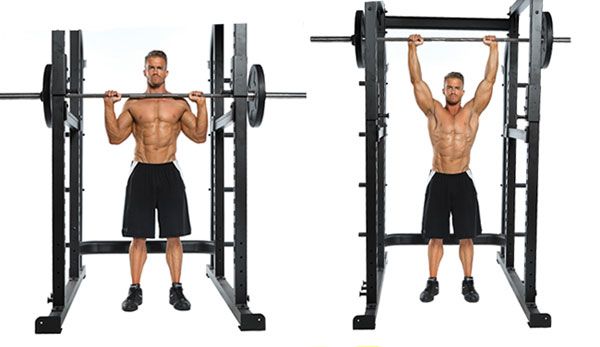
All about the army bench press: correct technique, elimination of errors
The Army Press (also called the standing barbell press from the chest or the classic shoulder press) is an excellent exercise aimed at developing the muscles of the arms and shoulders. At the same time, the athlete improves the support-shock-absorbing qualities of his body.
Muscle work in the exercise
Army-style barbell chest press ( military, soldier) is a basic exercise. That is, when performing it, several muscle groups work at once. The main load falls on the deltoids – the muscles that cover the shoulder joint. The back, front and middle beams are involved in the work. The maximum is front, the minimum is the rear.
Regular deltoid training makes the shoulders visually wider and fuller.
In addition to the shoulders, the movement involves the triceps (after all, you unbend your arms when you lift the bar in front of you) and the upper part of the pectoralis major muscles.
The muscles of the press, back, legs and buttocks are responsible for stabilizing the body during the exercise while standing. If you do a bench press while sitting on a bench with support on a vertical back, the load from the legs is completely removed, and the load on the back is significantly reduced. In general, the seated press is a somewhat simpler and safer exercise.
The beauty of the army press
Like As the name suggests, the military bench press is a traditional element of the physical training of military personnel. The name came from the English language, but quite adapted among Russian-speaking athletes.
The functionality of the exercises in the case of military training comes first. The standing press (lifting the barbell overhead) allows you to increase the force of the vertical push from the shoulders, which allows you to effectively hitch the fighters when needed. For example, to overcome high obstacles, or when you need to get into a high-positioned window.
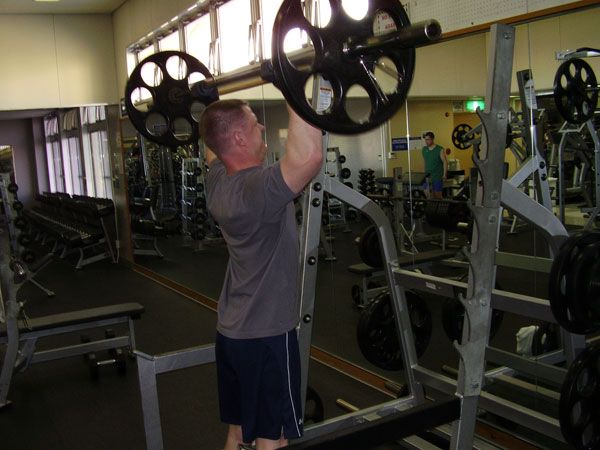
The exercise is performed while standing (the bench press is a simplified version of it), and the weight of the bar falls on everything body. You need to maintain balance throughout the exercise. This allows you to develop muscles that stabilize the position of the human body in an upright position. As a result, the muscles of the legs, back, and lower back are strengthened.
Since the bench press uses the triceps (as mentioned above), it will be useful during the fight, when you need to push the opponent away from you.
Thus, the army press (aka vertical press) is a basic exercise for a fighter.
Civilian athletes are interested not only in muscle strength and increasing the capabilities of their own body, but also in the harmony of the figure, which achieved through the development of the shoulder girdle.
In fitness clubs, athletes perform overhead press both standing and sitting. Both options develop the shoulders well. The first is suitable for experienced athletes, and the second is good for beginners or people with back problems.
If you consider the chest press in front of you as an element of strength training, then there is a push, and a snatch, and braking for leg amortization account. More on this in the technique of execution.
The big plus of the exercise is that it develops the whole body (not just the shoulder muscles), overall coordination and stability. This is good for both the soldier and the civilian athlete.
In civilian life, it is unlikely that you will need to lift someone over your head, sit down, and so on. But the exercise will be very useful for opening hatches, skylights, lifting something high up. So pump up your shoulders.
Now let’s talk about the cons
The army press combines two serious cons:
- Risk of injury (muscles and joints can be injured).
- Risk of falling and dropping the barbell (especially when the technique is incorrect).
The point is that the overhead press implies movement with the damping of the inertia of the descending projectile. This occurs due to bending of the knees and a slight deviation of the pelvis from the starting position.
If you press while standing on straight legs, there will be no shock absorption, and the impact will be absorbed due to the elasticity of the articular cartilage. This means that the joints of the knees, pelvis, spine, and ankles will receive a harmful load. All of this is easy to achieve if you do the army press on straight legs (that is, the knees are “snapped”).
Another risk is the increased load on the lower back. Therefore, it is recommended to perform the exercise with a specific athletic belt. If for some reason you have osteochondrosis of the lumbar spine, and the doctor recommended an orthopedic belt, wear it during approaches. This will reduce the amount of compression in the spine.
The most ridiculous thing that can happen is the barbell falling or knocking to the floor. This can happen for several reasons: you have taken a lot of weight, you are not an experienced athlete. For athletes with little experience, we strongly recommend that you work out the exercise technique before increasing working weights.
Also at risk are the muscles of the shoulders and shoulder joints. In no case should you start doing the army press without thorough preliminary warming up.
Technique of the exercise
Prepare the barbell racks: set them to the desired height. You can use a power rack or regular squat racks. To warm up, do 10-12 reps with an empty bar.
An empty bar (Olympic) weighs about 20 kg, including the plugs – 25 kg. For beginners, this is a solid weight, so look around the gym for lighter bars.
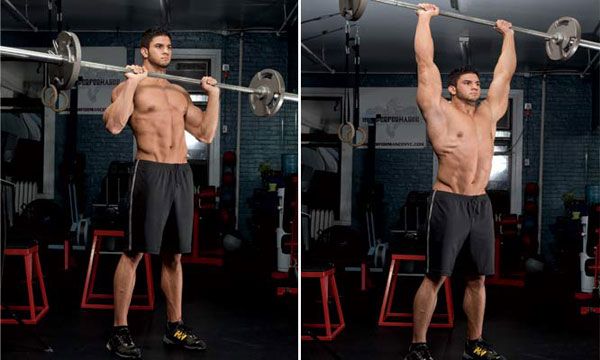
Army Press Technique:
- The bar should be slightly below your shoulders so that you can remove it by extending your knees rather than raising your body on your toes.
- The arms should be shoulder-width apart or slightly wider than your shoulders. Elbows down, palms up.
- Go under the barbell until you touch the bar, place your feet shoulder-width apart, feet parallel, with your toes slightly apart.
- Grasp the bar. as described in step 2. The bar should rest on your collarbones and rest on your palms at the sides of them.
- Bend your knees for cushioning. Raise the barbell up in front of you, bringing it out over your head. The bar should be in line with your head, pelvis, and heels. If the barbell deflects somewhere, you are doing the overhead press incorrectly!
- Lower the barbell back onto your collarbones, crouching slightly when the barbell touches them. Movements are carried out at a moderate speed, not slow, but not fast either. From the outside it looks like a jerk, but it is not. Each movement should be fully controlled by the athlete.
- Do 10-12 repetitions in three approaches.
Do not forget that when lifting the bar (on effort), you need to exhale through the mouth , and when lowering, inhale through the nose.
Those who want to completely protect themselves from injuries can perform a barbell press while sitting on an incline bench, placing their back at 90 degrees to the floor and pressing their back tightly against it. In this case, you completely eliminate injuries to the lower back and back, since they are fixed on the back of the bench and receive only part of the load. However, the seated press will not allow you to develop your jerking skills, develop more strength, and learn to better keep your balance. Therefore, think for yourself which option is best for you: standing barbell press, or still in a sitting position.
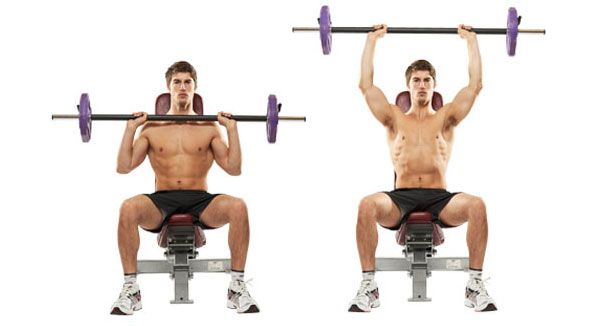
Watching the technique: frequent mistakes
Confusing with other exercises
With the army press often confuse the barbell press because of the head. In the second case, the bar goes up and down behind the head, and the athlete’s hands grab the bar wider than the shoulders. When the bar is lowered, it goes to the top of the trapezoid, or even more often, does not fall below the athlete’s ears. In the case of the military bench press, the bar should be held on the chest-collarbones, supporting it with the palms facing the athlete.
Excessive movements
We are talking about unnecessary pelvic vibrations , head movements, bouncing. If you pull your pelvis back a lot while lifting the bar, you are doing the exercise incorrectly.
If you jump to lift more weight, you are cheating, there is a risk of injury when lowering. Before sets, remember how to do the exercise using an empty bar.
Incorrect body position
Some thrill-seekers lift the bar up in front of them, tilting the body back, thereby overloading the vertical stabilizers. Firstly, you can fall, and secondly, injure your shoulders and lower back.
The barbell should be held above the head (while looking forward), and the body should be upright.
Too heavy weight
The most common mistake newbies make is wanting to impress. Remember, you will not make any impression on the longtime inhabitants of the gym, unless you make them laugh. And for the sake of other newbies, it’s not even worth showing off. The price is too high.
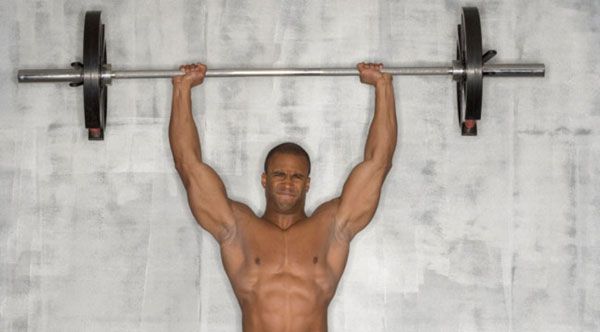
For example, you take a 50 kg barbell and try to lift it up in a clean and jerk. Once you will succeed, and then you will not be able to keep it. You need to correctly select the weight. To begin with, ensure that the execution technique is close to ideal, do the exercise correctly. Then you can already increase the weight. Technique is everything. There is a technique – there will be a result. If it is not, there will be an injury.
Lack of warm-up
A very risky and common mistake is to immediately take on working weights. The shoulders and their muscles are very vulnerable to injury. Many of you know perfectly well how all this happens – at first there is a sharp pain, then for six months it is difficult (or even impossible) to raise your hand in any direction. This is how the deltoid tearing process proceeds.
It takes a long time to heal, it requires compliance with restrictions, additional warming up in the future.
Do you need this? Warm up your muscles well before exercise. After cardio, work on your shoulder joint, then do this exercise with a light weight. If your gym has all 20kg bars, try stretching with dumbbells. This is very convenient – because the weight is significantly less than that of the bar. Do 10-15 warm-up reps. Then grab the bar, and gradually approach the working weight.
It is better to do 2-3 intermediate approaches 4-5 times, than to pull the shoulder. And remember – doing it right is just as important as warming up.
For example, if your working weight is 55 kg, start your warm-up with an empty bar (that’s 20 kg). Do 15 reps. Add 10 kg, do 4-5 reps. Hang another 10 kg, do the exercise 5 times. Now you can hang the working weight (55 kg) and perform the required number of repetitions and approaches.
Potential problems and their solutions
It hurts to lift the barbell
The pain is most often observed in the shoulders, triceps and wrists … If you work without a special belt, then the lower back can also hurt.
- If your shoulders hurt, one of the deltas is pulled (your choice: middle or front). You need to wait a while without training – let the muscles recover for at least a month.
- If your lower back hurts, always wear an orthopedic belt (not athletic, mind you).
- For pain in the wrists, you can use elastic bandages.
I can’t keep my balance
There is another way of setting the legs – one in front, the other slightly behind … However, it is used more by weightlifters. Thus, a person is more stable on his feet, but a traumatic load on the spine is created. Therefore, place your legs straight (feet parallel) and take as much weight that you can keep in that position. For convenience, practice in front of a mirror.
Lack of joint flexibility
If your joints do not allow you to perform the barbell press correctly from the chest, do not. We’ll have to limit ourselves to other options for pumping the shoulders. Don’t worry, there are tons of other exercises.
If your back hurts
Seated barbell press is an option for people with a weak back. Lean against the back of the incline bench. This will reduce the stress on the lower back. Also, the seated barbell press will reduce the risk of falling or dropping the barbell.
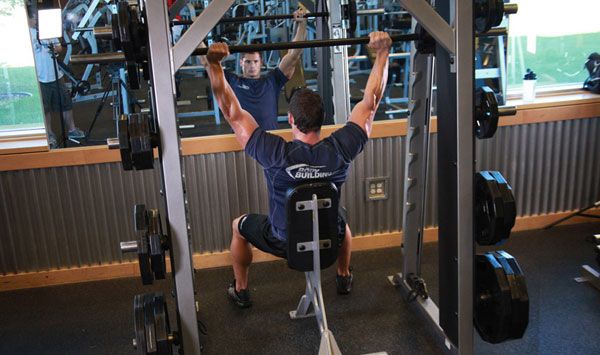
Overtraining
Don’t forget which muscle groups work when you bench press or sit, and plan your workouts correctly. Don’t download deltoids too often.
